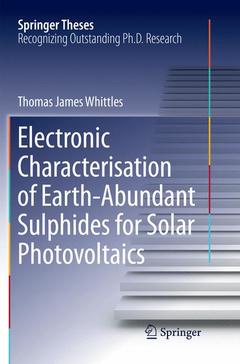Description
Electronic Characterisation of Earth‐Abundant Sulphides for Solar Photovoltaics, Softcover reprint of the original 1st ed. 2018
Springer Theses Series
Author: Whittles Thomas James
Language: English
105.49 €
In Print (Delivery period: 15 days).
Add to cart
Electronic Characterisation of Earth‐Abundant Sulphides for Solar Photovoltaics
Publication date: 02-2019
Support: Print on demand
Publication date: 02-2019
Support: Print on demand
Approximative price 105.49 €
In Print (Delivery period: 15 days).
Add to cart
Electronic Characterisation of Earth‐Abundant Sulphides for Solar Photovoltaics
Publication date: 08-2018
Support: Print on demand
Publication date: 08-2018
Support: Print on demand
Description
/li>Contents
/li>Biography
/li>Comment
/li>
This book examines the electronic structure of earth-abundant and environmentally friendly materials for use as absorber layers within photovoltaic cells. The corroboration between high-quality photoemission measurements and density of states calculations yields valuable insights into why these materials have demonstrated poor device efficiencies in the vast literature cited. The book shows how the materials? underlying electronic structures affect their properties, and how the band positions make them unsuitable for use with established solar cell technologies. After explaining these poor efficiencies, the book offers alternative window layer materials to improve the use of these absorbers. The power of photoemission and interpretation of the data in terms of factors generally overlooked in the literature, such as the materials? oxidation and phase impurity, is demonstrated. Representing a unique reference guide, the book will be of considerable interest and value to members of the photoemission community engaged in solar cell research, and to a wider materials science audience as well.
Introduction.- Experimental Methods.- The Electronic Structure of CuSbS₂ for Use as a PV Absorber.- The Electronic Structure of Cu₃BiS₃ for Use as a PV Absorber.- The Electronic Structure of Cu₃BiS₃ for Use as a PV Absorber.- The Use of Photoemission Spectroscopies for the Characterisation and Identification of Cu₂ZnSnS₄ and its Secondary Phases.- Conclusions and Recommendations for the Future.
Having graduated with a Master's degree in physics from the University of Durham, UK, Thomas Whittles then completed his PhD at the University of Liverpool, UK, producing the work presented in this book. He now lives in Germany, and is about to begin a postdoctoral placement at the Max Planck Institute for Solid State Research in Stuttgart.
Nominated as an outstanding Ph.D. thesis by the University of Liverpool, Liverpool, UK Represents an important contribution to our understanding of selected new solar cell materials and shows an impressive command of several complex characterization techniques Color figures help to elucidate the correlation between the measurement and computation of energy levels, and its implications for solar cell design
© 2024 LAVOISIER S.A.S.




